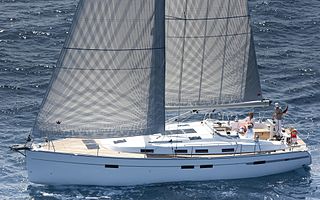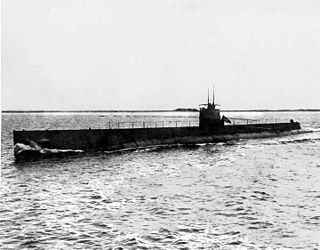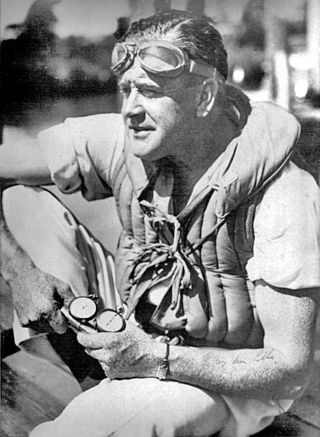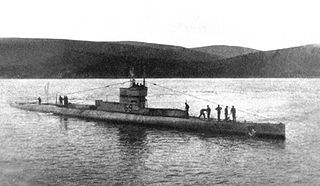Related Research Articles

A yacht is a sailing or power vessel used for pleasure, cruising, or racing. There is no standard definition, though the term generally applies to vessels with a cabin intended for overnight use. To be termed a yacht, as opposed to a boat, such a pleasure vessel is likely to be at least 33 feet (10 m) in length and may have been judged to have good aesthetic qualities.

An electric boat is a powered watercraft driven by electric motors, which are powered by either on-board battery packs, solar panels or generators.

USS Cuttlefish (SC-5/SS-171), a Cachalot-class submarine and one of the "V-boats," was the second ship of the United States Navy to be named for the cuttlefish. Her keel was laid down by Electric Boat Company in Groton, Connecticut. She was launched on 21 November 1933 sponsored by Mrs. B. S. Bullard, and commissioned on 8 June 1934, Lieutenant Commander Charles W. "Gin" Styer in command. Cuttlefish was the first submarine built entirely at Electric Boat's facility in Groton, Connecticut; construction of previous Electric Boat designs had been subcontracted to other shipyards, notably Fore River Shipbuilding of Quincy, Massachusetts. Four Peruvian R-class submarines had previously been finished in Groton, using material from cancelled S-boats salvaged from Fore River.

The Kairyu was a class of midget submarines of the Imperial Japanese Navy, designed in 1943–1944, and produced from the beginning of 1945. These submarines were meant to meet the invading American naval forces upon their anticipated approach of Tokyo.

The AA-1 class was a class of three experimental submarines of the United States Navy, built toward the end of World War I, between 1916 and 1919, intended to produce a high-speed fleet submarine. The design was not a success and none of the submarines saw active service. However, the lessons learned were applied to the design of the later V-boats. The class was later renamed as the T class.

The United States' S-class submarines, often simply called S-boats, were the first class of submarines with a significant number built to United States Navy designs. They made up the bulk of the USN submarine service in the interwar years and could be found in every theater of operations. While not considered "Fleet Submarines" in the traditional sense of that term, they were the first submarines in the USN designed for open ocean, blue water operations. All previous submarines had been intended for harbor or coastal defense. These boats were intended to have greater speed and range than previous classes, with improved habitability and greater armament.

USS Impetuous (PYc-46) was a private yacht purchased by the Navy in August 1940 that served as a patrol boat of the United States Navy in Central America. The yacht was built as Paragon, the first of at least two Davol yachts to bear the name, in 1915 for Charles J. Davol of Providence, Rhode Island. In 1916 Davol sold the yacht to John Fred Betz, 3d of Philadelphia who renamed the yacht Sybilla III which served as the Section Patrol yacht USS Sybilla III (SP-104) from May 1917 to December 1918. Sybilla III remained in Betz's ownership until sale in 1935 to R. Livingston Sullivan of Philadelphia who renamed the yacht Arlis. On 12 August 1940 the Navy purchased the yacht placing it in commission as USS PC-454 on 16 October. The vessel was given the name Impetuous and reclassified PYc-46 on 15 July 1943. The yacht was decommissioned at Philadelphia 31 August 1944 and transferred to the War Shipping Administration for sale.

Frank Taylor Cable was an early pioneer in submarine development and piloted the first United States Navy submarine, USS Holland during its pre-commissioning trials.

Hubert Scott-Paine was a British aircraft and boat designer, record-breaking power boat racer, entrepreneur, inventor, and sponsor of the winning entry in the 1922 Schneider Trophy.

The Royal Navy's G class of diesel/electric submarines were launched between 1914 and 1917, and intended for operations in the North Sea and German Bight in World War I against German U-boats.

The United States D-class submarines were a trio of submarines built for the United States Navy in the first decade of the 20th century. All three ships served during World War I providing training for crews and officers on the US East Coast, before the class was decommissioned and sold for scrap in 1922.

The United States N-class submarines were a class of seven coastal defense submarines built for the United States Navy during World War I.

The Electric Launch Company, later renamed Elco Motor Yachts ("Elco"), is an American boat building and electric motor company that has operated from 1893 to 1949 and from 1987 to the present.

Idealia was America's first diesel powered yacht built and owned by the Electric Launch Company (ELCO). The yacht was built in 1911, launched in 1912 and demonstrated the potential for use of diesel engines in yachts for several years thereafter. She yacht performed a public trial on the Hudson River on 22 October 1913 under the supervision of ELCO's manager Henry R. Sutphen with a gathering of naval architects and engineers as observers. Idealia was sold to individual owners after its period of demonstrating the diesel engine's pleasure craft utility.

USS Druid (SP-321) was a private yacht launched 10 February 1902 as Rheclair that was built for Daniel G. Reid. Reid sold the yacht to Senator Nelson W. Aldrich who renamed the yacht Nirvana only just over a year before his death. Aldrich's estate chartered Nirvana to John Wanamaker until it was bought by his son Rodman Wanamaker who used the yacht for cruising until a fire on 14 December 1916, just before a cruise south, severely damaged the vessel. He chartered an alternate vessel for his trip south and, after full repairs, the yacht was sold to Walter W. Dwyer who gave it the name Druid with intentions to sell the yacht to the government in order to finance a shipyard venture in Pensacola, Florida.

BAP Abtao (SS-42) is an Abtao-class submarine of the Peruvian Navy. The vessel which was originally named BAP Tiburón ("Shark"), was constructed by the American Electric Boat company in the United States and launched in 1953. The Abtao class were the last submarines constructed by the United States for the export market. The submarine entered service in 1954 and by presidential decree, was renamed Abtao for the battle during the Chincha Islands War.

Suquamish, built in 1914, was the first diesel-engined passenger vessel in the United States. Much later Suquamish was converted to a commercial fishing vessel and was registered as a Canadian vessel under the name Terry.
The Electro-Dynamic Company manufactured electric motors and generators 1880–2000, principally as a subsidiary of the Electric Boat Division of General Dynamics and its predecessors.

Amiral Bourgois was one of four experimental submarines ordered for the French Navy in 1906. Each boat was built to a different design and Amiral Bourgois was intended to test a novel powerplant. The experimental diesel engines took over six years to build and greatly delayed the boat's completion until 1913. Although engine problems plagued the submarine throughout her service, she was commissioned shortly after the start of the First World War in 1914, but never made an operational patrol. Amiral Bourgois was under repair when the war ended in 1918, but the work was cancelled shortly afterwards. The boat was struck the following year and offered for sale in 1920. There were no offers and she was used for torpedo testing in 1924–1926. The submarine was sold for scrap in 1927.
References
- Citations
- ↑ "Electric Boat". navyleague.org. Archived from the original on 18 February 2010. Retrieved 25 February 2010.
- ↑ Weir, p. 15–16
- ↑ Gardiner, p. 127–128
- ↑ "The New London Ship and Engine Company". The Day . New London, Connecticut. March 11, 1915. p. 3. Retrieved 25 February 2010.
- ↑ Speed-Up, from Submarine Boat Company, NELSECO Motors, 1923
- 1 2 "Motor Yacht Equipped With Diesel Engines". International Marine Engineering. Vol. 18, no. 4. April 1913. pp. 163–165. Retrieved 10 October 2018.
- 1 2 "America's First Diesel Yacht". Motor Boating. Vol. 10, no. 3. September 1912. p. 24. Retrieved 10 October 2018.
- ↑ Forty Eighth Annual List of Merchant Vessels of the United States, Year ended June 30, 1916. Washington, D.C.: Department of Commerce and Labor, Bureau of Navigation. 1916. p. 83. Retrieved 10 October 2018.
- ↑ "Yacht Diesel Engines". The Rudder. Vol. 31, no. 5. May 1915. p. 232. Retrieved 10 October 2018.
- ↑ "New London Ship & Engine Company". The Rudder. Vol. 31, no. 2. February 1915. p. 81. Retrieved 10 October 2018.
- ↑ Hamilton, Robert A. (2015). "EB, the No. 1 sub maker". General Dynamics Electric Boat. Retrieved 29 May 2015.
- ↑ Personal section, The Marine Review May 1913, p. 170
- Bibliography
- Gardiner, Robert; Gray, Randal (1985). Conway's All the World's Fighting Ships 1906-1921. London: Conway Maritime Press. ISBN 0-85177-245-5.
- Weir, Gary E.; Allard, Dean C. (2000). Building American Submarines, 1914-1940. The Minerva Group, Inc. ISBN 978-0-89875-066-9 . Retrieved 29 May 2015.